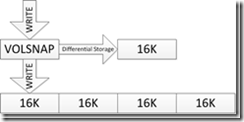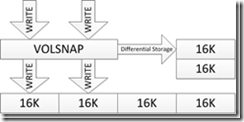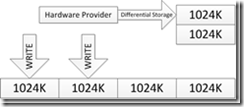Exchange / VSS / and differential block size…
Today’s backup and restore operations require close coordination between backup applications, the line-of-business application being backed up (for example, Exchange 2010), and the storage management hardware and software. The Volume Shadow Copy Service (VSS) in Windows Server 2008, which was first introduced in Windows Server 2003, facilitates the conversation between these components to allow them to work together. When all of the components support VSS, you can use them to back up your application data, such as mailbox and public folder databases.
VSS coordinates the actions that are required to create a consistent shadow copy (also known as a snapshot or a point-in-time copy) of the data that is to be backed up. Shadow copies use differential copy-on-write technology to maintain consistency during the lifecycle of the snapshot. For more information on how this works, see https://en.wikipedia.org/wiki/Shadow_Copy and https://en.wikipedia.org/wiki/Snapshot_(computer_storage).
There are three primary VSS components: providers, requestors, and writers. The provider is the system-level component that performs the actual work of creating and representing shadow copies. The requestor is the backup application, such as Windows Server Backup, System Center Data Protection Manager, etc., that requests a backup from the provider. And the writer is application (or component within an application) that coordinates its I/O operations with VSS shadow copy and shadow copy related operations (such as backups and restores) so that their data contained on the shadow copied volume is in a consistent state.
Before choosing a VSS-based backup application for Exchange, I recommend that you check with the vendor to determine which provider their application (the requestor) uses, and specifically, what differential block sizes are used. This is important because the block size used impacts how efficiently storage will be utilized.
Let me explain why.
The built-in provider in Windows, which leverages VOLSNAP.sys, uses a differential block size of 16K.
If a snapshot has been created, VOLSNAP.sys begins to intercept writes to the volume. If a single byte in 16K has changed, VOLSNAP.sys moves the original 16K to differential storage and allows the new write to proceed to the volume.
If a write happens to span more than one 16K block then all blocks that are changed are moved to differential storage.
Let’s look at how this might impact an application like Exchange. Exchange writes in a static page size.
- Exchange 2003 – 4K
- Exchange 2007 – 8K
- Exchange 2010 – 32K
In the Exchange 2007 example, if a single write of 8K was located on a single 16K differential block size, only 16K is moved to differential storage. If the 8K spanned two 16K differential blocks then 32K would be moved to differential storage.
Most VSS-based backup applications leverage the built-in VSS provider. However, it is not a requirement to do so, and some vendors instead implement their own providers. In these cases, the vendor may also choose to implement a larger or smaller differential block size.
Let’s look at the example of a hardware-based provider that implements a VSS solution with a block size of 1024K. In this example, if a single byte changes in a 1024K differential block, then 1024K of data is moved to differential storage. For applications like Exchange that write data in static pages, this can have can negative consequences.
For example, Exchange 2007 writes an 8K page to a single 1024K differential block. This results in 1024K being written to shadow storage. Therefore, 1 MB of storage is used to store 8K of data change.
Worse, if the write of 8K spans two 1024K differential blocks this results in 2048K being written to shadow storage. In this case, 2 MB of storage is used to store 8K of data change.
In some cases, the custom block size used by a vendor’s custom provider has a range of configurations. And in some cases, it cannot be configured at all. Before implementing a solution, consult with the vendor to determine which provider they use. If they use a custom provider, verify that it works efficiently with your version of Exchange.
*I want to thank Scott Schnoll and Dennis Middleton for tech reviewing and editing this post.




